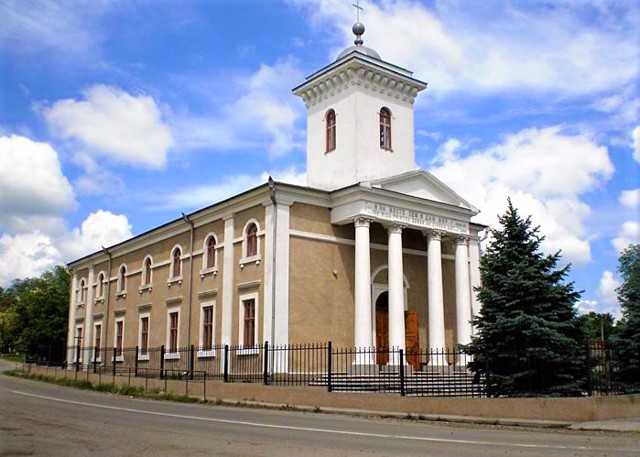Functional temporarily unavailable
General information about Sarata
Town Sarata is located on the territory of Odesa region and is administratively part of Bilhorod-Dnistrovskyi district of this region. According to the Codifier of Administrative Territorial Units and Territories of Territorial Communities of Ukraine, the settlement Sarata has the code UA51040190010067512.
The district center of the Bilhorod-Dnistrovskyi district is a city Bilhorod-Dnistrovskyi. The distance from the district center to the settlement Sarata is 56 kilometers in a straight line (the length of the road route may be longer).
A detailed description of ...
Town Sarata is located on the territory of Odesa region and is administratively part of Bilhorod-Dnistrovskyi district of this region. According to the Codifier of Administrative Territorial Units and Territories of Territorial Communities of Ukraine, the settlement Sarata has the code UA51040190010067512.
The district center of the Bilhorod-Dnistrovskyi district is a city Bilhorod-Dnistrovskyi. The distance from the district center to the settlement Sarata is 56 kilometers in a straight line (the length of the road route may be longer).
A detailed description of Sarata, including geographical location, date of foundation, history of the settlement of Sarata with main historical events and persons, main sights and interesting places of Sarata, not yet available.
Cелище Сарата розташоване на території Одеської області та адміністративно входить до складу Білгород-Дністровського району цієї області. Згідно з Кодифікатором адміністративно-територіальних одиниць та територій територіальних громад України, населений пункт Сарата має код UA51040190010067512.
Районним центром Білгорода-Дністровського району є місто Білгород-Дністровський. Відстань від райцентру до населеного пункта Сарата становить 56 кілометрів по прямій (довжина маршруту автомобільними дорогами може бути більшою).
Детальний опис Сарати, що включає географічне ...
Cелище Сарата розташоване на території Одеської області та адміністративно входить до складу Білгород-Дністровського району цієї області. Згідно з Кодифікатором адміністративно-територіальних одиниць та територій територіальних громад України, населений пункт Сарата має код UA51040190010067512.
Районним центром Білгорода-Дністровського району є місто Білгород-Дністровський. Відстань від райцентру до населеного пункта Сарата становить 56 кілометрів по прямій (довжина маршруту автомобільними дорогами може бути більшою).
Детальний опис Сарати, що включає географічне розташування, дату заснування, історію населеного пункта Сарата з основними історичними подіями та персонами, основні пам'ятки та цікаві місця Сарати, поки що відсутній.
Сплануй своє перебування у Sarata
What to see and where to go in Sarata
Tourist attractions and museums of Sarata

Lutheran Church
Temple , Architecture
The Lutheran church in Sarata was built and opened in 1840 by German colonists who settled here in 1822. An organ was installed in the church.
After the Soviet authorities evicted the Germans from Bessarabia, the church was closed, the building was used for other purposes - it housed an officers' house, then a house of culture.
Only in 1995, thanks to donations from Germany, the Lutheran church was reconstructed and consecrated again.

Sarata Historical and Local Lore Museum
Museum / gallery
The Sarata Historical and Local History Museum dates back to the 1922 exhibition of ancient artifacts dedicated to the 100th anniversary of the Sarata colony. In the same year, the first public museum opened its doors, which existed at the expense of voluntary contributions from the founding members of the museum association. For eight years, the museum was located in the house of the chairman of the Vahner Museum Association, and since 1930 - in the famous Verner School. In 1940 of the last century, the German population was forced to leave their homes and leave for Europe, taking with them part of the exhibits.
Only in 1955, on the initiative of the then director of the Sarata comprehensive school, a museum room was organized. In 1969, a historical and local history museum was opened, which was located at the district department of culture.
The current Sarata Historical and Local Lore Museum was opened in 1990. The museum's exhibition area is 130 square meters. The museum exposition is divided into six sections, each of which shows the life of the village in different years: "Traces of the Great Cultures of Bessarabia. Socio-Economic Development in the 19th Century", "Foundation of Sarata. Its Development from 1822 to 1940", "Romanian Period (1918-1940)", "World War II (1939-1945)", "Post-war Period", "Modern Period".
Dishes, clothing, household items, tools, furniture, towels - each exhibit has a separate long-standing history. There are a lot of documents and photographs that clearly tell about the life of the village in the 20th century.
A new separate section is dedicated to the events of the Revolution of Dignity and the Russian-Ukrainian War.
Reviews Sarata
Geographical information about Sarata
| {{itemKey}} | {{itemValue}} |
|---|---|
| Region |
Odesa |


